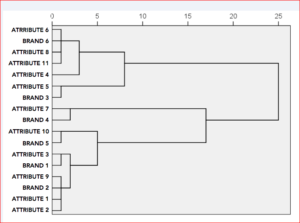OBJECTIVE
Marketers have always had to manage goals such as making their brands distinctive, making them central in their category, and understand competitors. The objective of the study was to understand how brands and a list of attributes/features are perceived by consumers. While understanding why a customer chooses a particular brand repeatedly over time, the aim was to ascertain the degree of differentiation in the market place and identify opportunities for the respective brands.
APPROACH
Correspondence analysis is a graphical display of the rows and columns (here, for example, brands and attributes) for cross tabulation. However, examining a cross-tab table and identifying relationships between rows and columns can be difficult and time consuming.
With the correspondence analysis map, we can arrive at more apparent conclusions and it allows us to quickly identify the association between the two or more categorical variables, but it fails to identify the order. From this, we could determine the list of attributes that contributed to the success of the respective brands.

Therefore, to strengthen the analysis further, we deployed a hybrid technique combining Correspondence Analysis and Hierarchical Clustering which helped us to understand the distance at which the clusters combines indicating the differentiation between them. It determined which attribute had a greater positive impact for the brand in comparison to the others.

OUTCOME
The graphical outcome of the above mentioned methods helped the client to gauge the relationship between the brands and their association with various products and service attributes/features as well as the order of their impact. Simply put, three results we achieved were – determining the attributes helpful for a brand’s success, understanding which attributes/list of attributes impacted more than others, and the comparison between the brands themselves.
Based on the analysis, client might change its views on the messages used in communications and on the website, highlighting how its brands are different and better.



